Santal people
The Santal or Santhal, are an ethnic group native to India and Bangladesh in South Asia. Santals are the largest tribe in the Jharkhand state of India in terms of population and are also found in the states of Assam,Tripura, Bihar, Odisha and West Bengal. They are the largest ethnic minority in northern Bangladesh's Rajshahi Division and Rangpur Division. They have a sizeable population in Nepal and Bhutan. The Santals mostly speak Santali, the most widely spoken of the Munda languages.
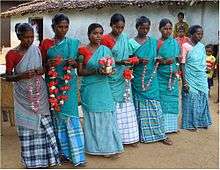 Santal women in traditional dress | |
| Total population | |
|---|---|
| c. 7.4 million | |
| Regions with significant populations | |
| India • Bangladesh • Nepal | |
Jharkhand | 2,752,723[1] |
| West Bengal | 2,512,331[1] |
| Odisha | 894,764[1] |
| Bihar | 406,076[1] |
| Assam | 213,139[2] |
| 300,061 (2001)[3] | |
| 42,698[4] | |
| Languages | |
| Santali | |
| Religion | |
| Hinduism • Folk religions (Sarna Dharam) • Christianity | |
| Related ethnic groups | |
| Mundas • Hos • Juangs • Kharias • Savaras • Korku | |
Etymology
Santal is most likely derived from the Bengali exonym. The term refers to inhabitants of Saont, now in the Mendinpur region of West Bengal, the traditional homeland of the Santals.[5] Their ethonym is Hor Hopon ("sons of mankind").[6]
Origins
According to linguist Paul Sidwell (2018), Austro-Asiatic language speakers probably arrived on coast of Odisha from Indochina about 4000–3500 years ago.[7] The Austroasiatic speaker spread from Southeast Asia and mixed extensively with local Indian populations.[8]>
The original homeland of the Santals was in the southeast of the Chota Nagpur plateau, modern-day southern Jharkhand and northern Odisha, and the Mendinpur district of southern West Bengal. Here they developed wet-rice agriculture.
History
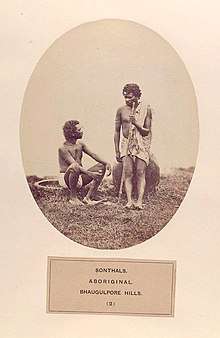
British officials intended to enhance the revenue by expansion of agriculture.[9] They encouraged the Mal Paharias of the Rajmahal hills (now in northeastern Jharkhand) to practice settled agriculture, but their way of life revolved around jhum agriculture and raiding of settled agriculturalists from their forest bases. Then British officials turned their attention to Santals, who were ready to clear the forest for the practice of settled agriculture. In 1832, a large number of areas were demarcated as Damin-i-koh. Santals from Cuttack, Dhalbhum, Birbhum, Manbhum and Hazaribagh, now in northern Odisha and western West Bengal migrated and started cultivating these lands. Under the British eyes, Santals took loans from non-Santal moneylenders to buy iron tools, seed grain and oxen as individuals and families, rather than groups as was their custom for working the land.[6]
When they arrived, the British provided no protection for the Santals against the Mal Paharias, who were known raiders of the plains areas and had only recently been partially "pacified." Eventually, the Santals, with their superior technology and ability to match the Paharia's guerrilla attacks, managed to drive them out. Their settlement took place between the 1830s and 1850s: in 1830, the area was home to only 3000 Santals, but by the 1850s, 83,000 Santals had settled in the land and had turned it into paddy fields. This resulted in a 22 times increase in Company revenue from the area.[6]
However, as they became more agricultural, their interactions with non-tribals and the British resulted in exploitation. Unlike the Santals, they valued individual competition instead of cooperation, and had a rigid system of laws very different from the relatively relaxed norms of the village council, the highest form of government most Santals knew. Non-Santals began selling goods from elsewhere, and many Santals, seeing them as exotic, were tricked into becoming in debt to buy them, usually with a mortgage on their land. When the Santals were unable to pay the moneylenders back, they became owners of the land and the Santals became peasants. Santals also began to be treated as outcastes in a newly-imposed Brahminical system.[6]
Eventually these oppressive conditions, combined with an unforgiving British tax policy and dishonest tax collectors, became so bad that the Santals could no longer bear them. In 1855, they revolted in the Santal rebellion, better known as the Santal Hul. 30,000 Santals, led by Sidhu and Kanhu Murmu, attacked the zamindars and other outsiders who had made their lives so miserable, as well as British tax collectors widely seen as corrupt and cruel. Eventually around 10,000 British troops managed to suppress the revolt. However the revolt is now remembered as a patriotic uprising against British oppression and a forebearer to the later 1857 rebellion.[9][10][11] Afterwards the British satisfied all their demands due to their importance as a tax-paying group. The British created an 5000 km2 area, called Santal Parganas, where the normal procedures of British India did not apply. Administration of the community was primarily made the responsibility of the village headman, or pradhan, who was also given the power to collect taxes. In addition, it was made illegal for Santals to transfer land to non-Santals, allowing them to have legal rights over their land.[6]
After the British Government formally took over in 1858, the Santals continued their system of government and traditions. Newly-established Christian missions brought secular education, and many Santals moved to the tea plantations in Assam, where they still remain today. However most continued with their old life, but were still not prosperous.[6]
After independence, the Santals were made one of the Scheduled Tribes. For the Santals, and other tribal groups, Jharkhand was carved out of Bihar in 2000. The Santal Parganas was made a separate division of the state.[6] These Santals have also agitated for recognition of their traditions as a separate religion, sarna dharam. Many still face poverty and exploitation, and in Bangladesh, theft of their lands is common. Although many still live in their traditional homelands, they now consider the Santal Parganas as their cultural heartland.[5]
Society
The base of Santal society is a division between "brother" (boeha) and "guest" (pera), a divide found in many other tribal societies of central and eastern India. Children of the same father (sometimes grandfather), known as nij boeha, often live next to each other and own adjacent pieces of land. Those in the closest form of brotherhood, called mit orak hor ("people of one house") in Singhbhum, cannot marry each other and propitiate the same deity, since the house refers to a common ancestor from which all the families are believed to descend. Only mit orak hor marriages are severely stigmatised. Another brotherhood is membership of a clan, which are exogamous. The last form of brotherhood is phul, a ritual friendship with members of other ethnic groups. Children of phul brothers consider themselves as brothers, and they attend each other's main lifecycle events, such as weddings or funerals, as pera. They also give help in times of hardship.[5]
Those who do not have brotherhood are referred to as pera, or guests. Members of other communities, especially those not speaking Santali, are excluded from this grouping, except for communities such as the Karmakar, Mahali or Lohar, who are enmeshed in Santal society. Those with this relationship can marry, and attend major festivals as guests. People related by marriage, although pera, have special roles in life-cycle events. Women perform special welcome rituals for pera when they visit. Those related by marriage can have one of two relationships. They can be bala, a relationship exemplified by the couple's parents, or sangat, between cross-siblings of a couple.[5]
Santal society has much less stratification and is more egalitarian than neighbouring caste Hindu society, but still has some status differences. The most important marker of a person when interacting with others in Santal society is their standing as marang ("senior") or hudin ("junior"). This standing is evaluated by relation: for example, is someone is greeting their father's elder brother's son, they would be the junior irrespective of age. Similarly, when someone greets their elder brother's wife, the wife would be marang. However for strangers or guests with no clear kin connections, the question of marang or hudin is decided by age. The ritual greeting (god in Santali) of someone is given much importance and is done in the courtyard of a house when a pera visits. The greeting differs by gender, and whether the person is junior or senior to the one being greeted. The greeting rituals given by a hudin involve a "offering" of respect, while a marang "receives" this respect. This greeting should not be done hastily, and correct practice of it is encouraged in children from a young age. However the hudin-marang distinction does not apply to phul or bala, who instead greet each other as if greeting a marang.[5]
The Santals also have totemistic clans, known as pari. These 12 clans are divided into two ranks: 7 senior and 5 junior. The senior clans are believed to originate from the 7 sons and daughters of the first man and woman, and in order of seniority they are: Hansda (goose), Murmu (Nilgae), Marndi (Ischaemum rugosum), Kisku (kingfisher), Soren (Pleiades), Hembrom (betel palm) and Tudu (owl). The junior clans are Baskey (stale rice), Besra (falcon), Caure (lizard), Pauria (pigeon) and Donker. Members of a senior clan do not marry members of a junior clan, and there are some forbidden marriages as well, such as between Marndi and Kisku. In addition, Besras are sometimes treated differently due to their perceived low status, but other than the context of marriage, they play no role in social life. The clans also avoid harming their clan totem, lest evil befall them.[5]
The Santals have another social organisation important for rituals, called khunti, or gusti in south Chota Nagpura. The term refers to descendants of a common ancestor, no more than a few generations back, that live nearby. The khunti is identified by some distinguishing feature of the ancestor, such as poeta, people who wear a thread on their chest in worship. In many cases, all the people of a gusti live in their ancestral village, but some members may have migrated to neighbouring villages.[5]
Religion
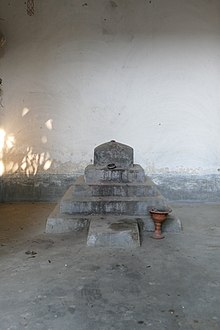
In the Santal religion, the majority of reverence falls on a court of spirits (bonga), who handle different aspects of the world and who are placated with prayers and offerings in order to ward off evil influences. These spirits operate at the village, household, ancestor, and sub-clan level, along with evil spirits that cause disease and can inhabit village boundaries, mountains, water, tigers, and the forest. The bonga are intermediaries between noa puri (visible world) and hana puri (the invisible reality), the abode of a Creator. This creator is variously called Marang Buru (Supreme Deity or literally The Great Mountain) or Thakur Jiu (life giver), and is the "cause of all causes," making the Santal religion, in a deep sense, monotheistic as well as pantheistic.[12]
The Santal creation story holds that originally the world was water, and Marang Buru and some lesser deities were the only inhabitants. When some spirits requested permission to make humans, Marang Buru asked Malan Budhi to create the human bodies. When she had finally succeeded, she was told by Marang Buru to use the human spirits that were high on the rafters of his hut. She could not reach the human spirit, and took the bird spirit instead. When Marang Buru integrated the spirits with the bodies, they flew away and asked for a place to build a nest. Marang Buru could not get anyone else to bring land to the surface, and so the tortoise volunteered and pushed the Earth onto his back. The birds then gave birth to a boy and a girl called Pilchu Haram and Pilchu Budhi. These two had seven sons and seven daughters, but the couple soon had a quarrel and separated. Pilchu Haram and his sons became great hunters, and on a time came upon the daughters, who had become maidens and were unrecognisable. They became introduced and made love. Looking for his sons, Pilchu Haram discovered an old woman and asked for fire, and upon talking to her more, he discovered his wife and reconciled with her. Another version tells how Pilchu Budhi was in fact in tears at her daughters' disappearance, but Marang Buru reassured her that they were all safe and brought her to reconcile with her husband. When their sons found out they had married their sisters, they were very angry and would have killed their parents if Marang Buru had not hidden them in a cave, where they stayed for the rest of their days. The children of these seven couples became the progenitors of the Santal clans.[13]
A characteristic feature of a Santal village is a sacred grove (known as the Jaher[14][5] or Santal Sthal) on the edge of the village where many spirits live and where a series of annual festivals take place.[15] The Manjhi Than, a raised mound of earth covered with a thatched roof outside the headman's house, is where the Manjhi's ancestors' spirits live. During the summer, a jug of water is placed there so the spirits can drink. Here the most important decisions of the village are made, including judgements.
A yearly round of rituals connected with the agricultural cycle, along with life-cycle rituals for birth, marriage and burial at death, involve petitions to the spirits and offerings that include the sacrifice of animals, usually birds. Religious leaders are male specialists in medical cures who practice divination and witchcraft (the socio-historic meaning of the term, used here, refers to the ritual practice of magic and is not pejorative). Similar beliefs are common among other tribes on the Chota Nagpur Plateau like the Kharia, Munda, and Oraon.[15]
Smaller and more isolated tribes often demonstrate articulated classification systems of the spiritual hierarchy less well documented, described as animism or a generalised worship of spiritual energies connected with locations, activities, and social groups. Religious concepts are intricately entwined with ideas about nature and interaction with local ecological systems. As in Santal religion, religious specialists are drawn from the village or family and serve a wide range of spiritual functions that focus on placating potentially dangerous spirits and co-ordinating rituals. These rituals include animal sacrifice, including cows, very unlike Brahminical Hinduism.[16][15]
According to the 2011 Indian Census, majority of the Santal's from Jharkhand follow Hinduism at 54%, with 37% following "other religions and persuasions," mainly Sarna Dharam. Christianity is practised by 8.3% present of the population. Islam, Sikhism, Buddhism and Jainism are followed by less than 1% of the population.[17]
Culture
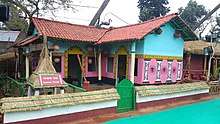
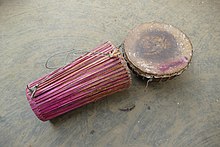
Sohrai is the principal festival of Santal community. Besides that Baha, Karam, Dansai, Sakrat, Mahmore, Rundo and Magsim are important festivals. They traditionally accompany many of their dances during these festivals with two drums: the Tamak‘ and the Tumdak’.
Chadar Badar, a form of puppetry known also as Santal puppetry, is a folk show involving wooden puppets placed in a small cage which acts as the stage.[18]
Decision-making matters is done through a village council which is headed by a person titled manjhi. The manjhi is aided by other council members to carry out and deal with local affairs.[19]
Santal art is noticeable for its intricate carving style. The walls of traditional Santal homes are ornamented with carved designs of animals, hunting scenes, dancing scenes, geometric patterns, and more. Santal-styled palanquins were also finely carved and designed.[19]

Notable people
- Birbaha Hansda, Santali-language actress and politician[20]
- Rathin Kisku, Baul singer.[21]
- Babulal Marandi, first chief minister of Jharkhand[22]
- Draupadi Murmu, BJP politician and Governor of Jharkhand[23]
- G. C. Murmu, first lieutenant governor of J&K (union territory)[24]
- Sidhu and Kanhu Murmu, freedom fighters[25]
- Uma Saren, Politician, MP from Jhargram[26]
- Hemant Soren, Chief Minister of Jharkhand[27]
- Shibu Soren, former chief minister of Jharkhand and president of Jharkhand Mukti Morcha[27]
- Raghunath Murmu, Inventor of Ol Chiki script.
- Bhagwat Murmu, Social worker, first Santal Padma Shri recipient,[28][29] Member of Bihar Legislative Assembly, 1957–1962.[30]
References
![]()
- "A-11 Individual Scheduled Tribe Primary Census Abstract Data and its Appendix". www.censusindia.gov.in. Office of the Registrar General & Census Commissioner, India. Retrieved 18 November 2017.
- "C-16 Population By Mother Tongue". www.censusindia.gov.in. Office of the Registrar General & Census Commissioner, India. Retrieved 3 November 2019.
- Cavallaro, Francesco; Rahman, Tania. "The Santals of Bangladesh" (PDF). ntu.edu.sg. Nayang Technical University. Retrieved 17 November 2017.
- "Santali: Also spoken in Nepal". Retrieved 1 April 2011.
- Schulte-Droesch, Lea Verfasser. (10 September 2018). Making place through ritual : land, environment and region among the Santal of Central India. ISBN 978-3-11-053973-8. OCLC 1054397811.
- Somers, George E. (1979). The dynamics of Santal traditions in a peasant society. Schenkman Pub. Co. OCLC 5668202.
- Sidwell, Paul. 2018. Austroasiatic Studies: state of the art in 2018. Presentation at the Graduate Institute of Linguistics, National Tsing Hua University, Taiwan, 22 May 2018.
- Schliesinger, Joachim (2016). Origin of the Tai People 3: Genetic and Archaeological Approaches. Booksmango. p. 71. ISBN 9781633239623. Retrieved 30 September 2019.
- Jha, Amar Nath (2009). "Locating the Ancient History of Santal Parganas". Proceedings of the Indian History Congress. 70: 185–196. ISSN 2249-1937. JSTOR 44147668.
- This is Our Homeland: A Collection of Essays on the Betrayal of Adivasi. 2007. Retrieved 26 August 2019.
- Malik, Dr Malti (1943). History of India. ISBN 9788173354984. Retrieved 26 August 2019.
- Debnath, Mrinal Kanti (28 February 2011). Living on the Edge: The Predicament of a Rural Indigenous Santal Community in Bangladesh (Thesis thesis).
- Bradley-Birt, Francis Bradley (1874-1963). (1998). Chota nagpur : a little-known province of Empire. Asian Educational Services. ISBN 81-206-1287-6. OCLC 491305077.
- "Jaher Worshiping Place of Santals". Retrieved 27 September 2014.
- "The Green Revolution in India". U.S. Library of Congress Country Studies (released in public domain). Retrieved 6 October 2007.
- Bisoee, Animesh (28 May 2019). "Brave show of support for arrested Santhal". The Telegraph. Retrieved 31 May 2019.
- "ST-14 Scheduled Tribe Population By Religious Community - Jharkhand". census.gov.in. Retrieved 3 November 2019.
- "Chadar Badar". Telegraph. 2015. Retrieved 22 March 2015.
- Winston, Robert, ed. (2004). Human: The Definitive Visual Guide. New York: Dorling Kindersley. p. 440. ISBN 0-7566-0520-2.
- Das, Madhuparna (2 April 2016). "Santhali actress Birbaha Hansda to fight West Bengal polls". The Economic Times. Retrieved 8 January 2020.
- "Baul international". The Telegraph. 18 November 2007. Retrieved 26 March 2020.
- "जिस BJP को दिलाई थी करिश्माई जीत, बाबूलाल मरांडी का उसी से हुआ मोहभंग". aajtak.intoday. 1 April 2019.
- "Draupadi Murmu may soon be the President of India: Know all about her". indiatoday.
- Das, Anand ST (1 November 2019). "'A Tribal Boy Got a Big Opportunity': GC Murmu's Mother Elated over His Appointment as J&K's L-G". News18. Retrieved 19 February 2020.
- Sailendra Nath Sen (2010). An Advanced History of Modern India. Macmillan. p. 120. ISBN 9780230328853.
- Seetharaman, G.; Balasubramanyam, K. R. (25 May 2014). "32 newly elected under-35 MPs & what they intend to do for their constituencies". The Economic Times. Retrieved 14 March 2019.
- "Shibu Soren". Britannica. Retrieved 3 February 2020.
- List of Padma Shri award recipients (1980–1989)
- Padma Awards, Ministry of Home Affairs, Govt. of India
- About Jhajha Legislative Assembly (Vidhan Sabha) Constituency
Notes
1.^a The term comes from the Bengali goshti, meaning clans. It seems likely that the nearby Santals of Singhbhum borrowed the word.
Bibliography
- Archer, W. G. The Hill of Flutes: Life, Love, and Poetry in Tribal India: A Portrait of the Santals. Pittsburgh: University of Pittsburgh Press, 1974.
- Bodding, P. O. Santal Folk Tales. Cambridge, Massachusetts: H. Aschehoug; Harvard University Press, 1925.
- Bodding, P. O. Santal Riddles and Witchcraft among the Santals. Oslo: A. W. Brøggers, 1940.
- Bodding, P. O. A Santal Dictionary (5 volumes), 1933–36 Oslo: J. Dybwad, 1929.
- Bodding, P. O. Materials for a Santali Grammar I, Dumka 1922
- Bodding, P. O. Studies in Santal Medicine and Connected Folklore (3 volumes), 1925–40
- Bompas, Cecil Henry, and Bodding, P. O. Folklore of the Santal Parganas. London: D. Nutt, 1909. Full text at Project Gutenberg.
- Chakrabarti, Dr. Byomkes, A Comparative Study of Santali and Bengali, KP Bagchi, Calcutta, 1994
- Culshaw, W. J. Tribal Heritage; a Study of the Santals. London: Lutterworth Press, 1949.
- Edward Duyker Tribal Guerrillas: The Santals of West Bengal and the Naxalite Movement, Oxford University Press, New Delhi, 1987, pp. 201, SBN 19 561938 2.
- Hembrom. T, The Santals: Anthropological-Theological Reflections on Santali & Biblical Creation Traditions. 1st ed. Calcutta: Punthi Pustak, 1996.
- Orans, Martin. "The Santal; a Tribe in Search of a Great Tradition." Based on thesis, University of Chicago., Wayne State University Press, 1965.
- Prasad, Onkar. Santal Music: A Study in Pattern and Process of Cultural Persistence, Tribal Studies of India Series; T 115. New Delhi: Inter-India Publications, 1985.
- Roy Chaudhury, Indu. Folk Tales of the Santals. 1st ed. Folk Tales of India Series, 13. New Delhi: Sterling Publishers, 1973.
- Troisi, J. The Santals: A Classified and Annotated Bibliography. New Delhi: Manohar Book Service, 1976.
- ———. Tribal Religion: Religious Beliefs and Practices among the Santals. New Delhi: Manohar, 2000.
External links
| Wikimedia Commons has media related to Santal. |
| Wikisource has the text of the 1905 New International Encyclopedia article Santals. |
- Saontal Voice in Bangladesh
- Santal Rebellion
- Santal Engineers' Welfare Association – Working for all round development of Adivasi
- All India Santal Welfare and Cultural Society
- Santal Arts
- Santal Dance
- Boro Baski: Santal worries
- Santal culture on Daricha Foundation website (Kolkata)
- Banam The bowed music instrument played by the Santals
- RWAAI | RWAAI, Lunds universitet RWAAI (Repository and Workspace for Austroasiatic Intangible Heritage)
- http://hdl.handle.net/10050/00-0000-0000-0003-A6AF-2@view Santali language in RWAAI Digital Archive

